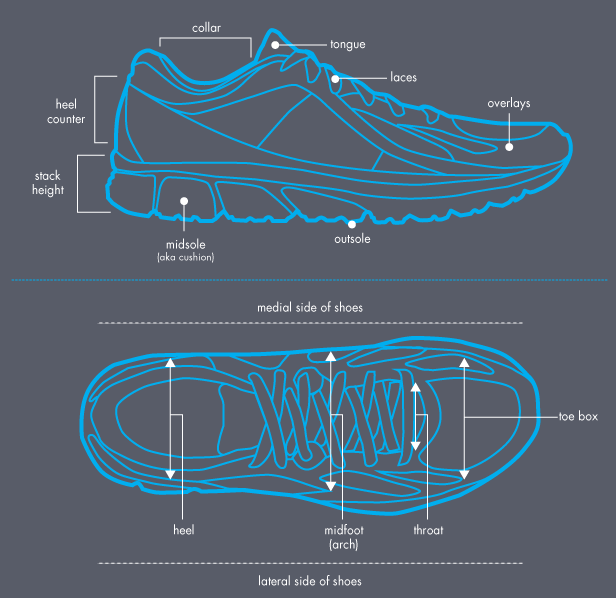
Ever heard a runner enthusiastically say things like, “What’s the heel-toe drop bro?” or “Bro, the midsole of your shoe is just insane” and you’re just standing there like ummmm…I bought these shoes because they felt comfortable… we’ve all been there before. Lugs? stack height? Gusseted tongue? What are all these lingos?
Don’t worry, we got you! We are going to study some anatomy, not just any anatomy, but anatomy of a running shoe. So, buckle up, we got some learning to do.
Anatomy of a Running Shoe
The running shoe essentially has 3 parts. ‘Upper’, the part that the eyes of a non-runner meet first, the most complex is the ‘Midsole’, the easiest part to understand which is the ‘Outsole’.
Different parts of a running shoe

Photo by: believeintherun.com
Upper

The upper portion is what provides breathability to the shoe. By that we mean, your feet would be a lot less sweaty because the mesh and fabric allow airflowAnyway, moving on to the parts of the upper.
- Tongue: This is the strip that you pull before you tie the lace. This helps in reducing the lace pressure.
- Heel counter: This part is what securely and comfortably locks the shoe around your heel.
- Heel collar: Just above the heel counter, this provides cushioning and padding around the ankle ensuring a comfortable snug fit.
- Laces: pretty self-explanatory right? It’s what you tie after you’re done wearing the shoe. Obviously, Some runners do enjoy a super snug fit but m
- Overlays: See the fancy line like decorations on the shoe? Well, they are more than just that, they often are made using reflective materials to increase visibility during the night. You can think of them as a reinforcing strip that provides structure to the shoe.
- Toe-box: This is where your toes rest and wiggle, make sure you have adequate space for your toes because your foot does swell up a little when running. Generally, we recommend a thumb width between your toe e end of the shoe. We call it the good old ‘thumb test’.
Outsole

Photo by Andrew Read
The underneath of the shoe with fancy patterns of rubber. Each company does extensive research to make the best possible rubber for their shoe. It’s what makes the shoe durable. Depending on the terrain you run on, the outsole may be segmented for smooth transition on pavement or have an aggressive lug like pattern for grip on a rugged terrain.
- Lugs: Remember we mentioned lugs in the beginning? They are nothing but the little grooves that provide additional grip to the rugged terrain. It’s mostly seen in trail running shoes.

Photo by Salomon
- Footbridge: Also known as a shank, it’s to provide additional support by reducing twisting of the shoe.
Midsole

Photo by Carlos Alvarez
That’s the midsole, the core, the superstar, and the lead singer that everyone remembers, ‘The Midsole’. The part that provides the holy ‘ENERGY RETURN’. Nothing too complex to understand, energy return is the bounce or spring you experience inside the shoe after the foot lands on the ground.
Essentially, the midsole is made up of a specialized foam. Usually, EVA (chemical compound that most of us wouldn’t remember) foam is used.
The big brands have their own science to construct their own gels and foams to provide the best possible cushioning, shock absorption.
Stack Height: it’s the measurement of the foam at it’s thickest. The amount of foam between your and foot and the ground. More stack height generally means that the shoe has more cushioning.
Conclusion:

We’ve covered quite a bit so let’s summarize it, shall we?
We went over the ‘upper’ which is the part that has overlays and makes the shoe attractive to look at.
The ‘midsole’ which is the core of a running shoe. Companies have their own science to make the foams and gels. It’s what differentiates a good running shoe from a mediocre running shoe.
Then, finally the ‘outsole’ is what touches the terrain. Depending on the terrain you choose to run on, you have varying outsoles.
That brings us to the end of the beginner’s guide to understanding the running shoe. You’ll be a lot less lost the next time a runner starts geeking out about his running shoes

